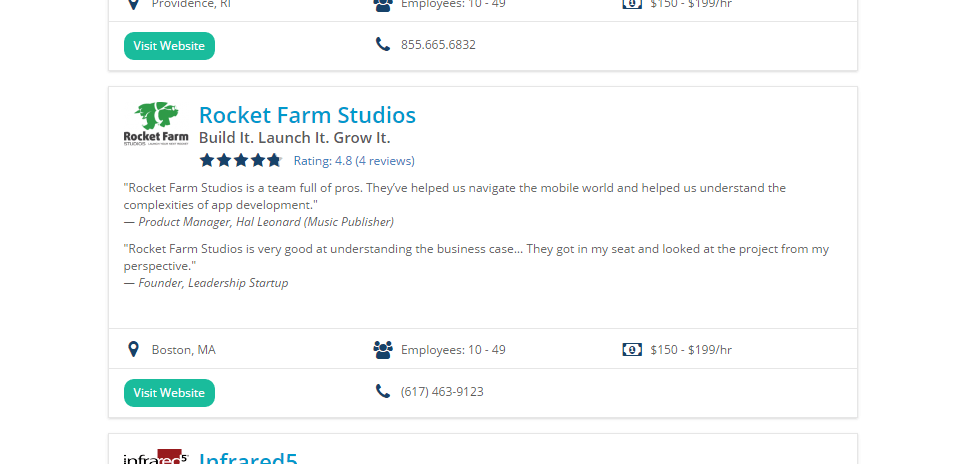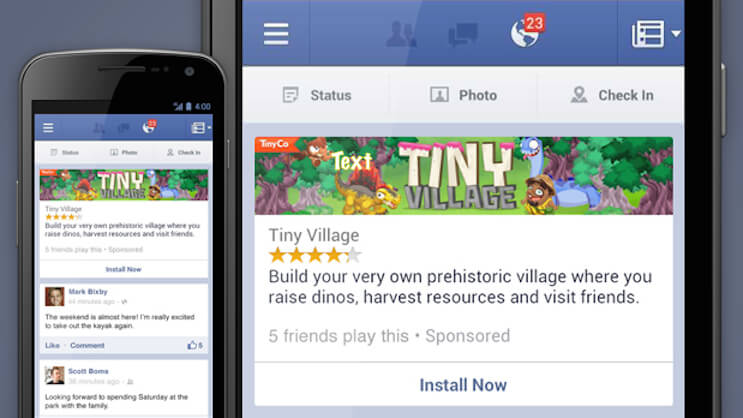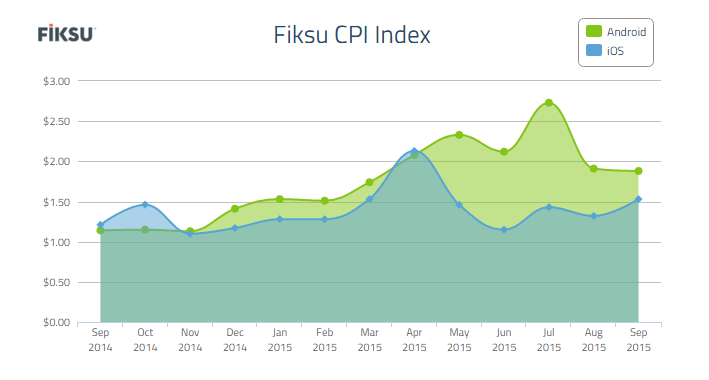Boston is at the cutting edge for a large variety of sectors, from biotech to financial services, and indeed in January 2015, Boston was the biggest city on the East Coast for venture capital, even beating out New York, and behind only San Francisco and San Jose nationally.
Month: November 2015
So, if you don’t know where to get started with a blueprint for your app, Rocket Farm Studios can take the pressure off.
Rocket Farm Studios Named Top App Developers in Boston
When you’re on a roll, you’re on a roll. Just this month, research firm Clutch.co ranked us as one of the top app developers in Boston! Clutch.co is an independent research firm (we could have saved a ton of money on all those muffin baskets!), so it’s great to get objective verification that we’re doing solid work here on The Farm. We’re proud to be listed with our peers on this list, we’re proud to have our customers rate us with high marks for our development and service, and we’re proud to be contributing to Boston’s amazing variety of tech businesses that are on the forefront of the industry.

We’ve come a long way from where we started and we’re gearing up for some amazing things in 2016, starting with this brand new website that you’re looking at right now. And while we’ve grown by leaps and bounds, we’re still dedicated to bringing the most comprehensive collaborative experience to our customers. We differentiate ourselves by the level of partnership we offer our clients, from conception to launch to marketing, and we’ve never been more focused on providing this service to SMBs and enterprise-level businesses.

Check out our Portfolio to see what we’ve done for our clients in the past. If you’re ready to launch your next app idea, we’re ready to light your rocket.

So, if you don’t know where to get started with a blueprint for your app, Rocket Farm Studios can take the pressure off.
3 Tips to Boost Your Word of Mouth App Marketing
App marketers, want some night terrors? Here’s a not-so-fun statistic: there are now 198 million active adblock users around the world, and the numbers are skyrocketing. Many of you might not even realize how dire a situation it is now that customers can choose not to see any ads at all, but marketers are very aware of this issue.
And sure, adblocking tech hasn’t quite crossed-over into the mobile world yet, but that’s no reason to think it never will. If the VP of Marketing Solutions at LinkedIn is telling us to take adblocking on mobile seriously, we should. That’s why in the near future, good old-fashioned word-of-mouth marketing might become one of the most powerful tools mobile businesses might have left to draw in new users.
Considering 92% of Americans trust recommendations from their family and friends, and word-of-mouth marketing drives searches for mobile apps, now is the time to put some calories behind this time-tested channel. Here are 3 ways to boost your word-of-mouth app marketing.
1. Ask *satisfied* customers for referrals and ratings.
Of course, it goes without saying that the larger your pool of loyal users, the greater your reach with word-of-mouth marketing. Make sure you cultivate loyalty by rewarding users with the right incentives to keep using your app. Great customer service and experience leads to happy stories which lead to more word-of-mouth conversions.
2. Give personalized referral codes for free trials and discounts.
Remember that 92% stat? You rarely see a percentage that high for anything in online marketing (well, anything positive), so it’s definitely something to pay attention to. A thousand online reviews might not sway you, but if your best friend swears by Waze as her navigation app of choice? You’ll probably download it the next time you’re on a road trip.
Create more opportunities for your users to talk up your app by rewarding them with personalized referral codes. Companies like Uber and TaskRabbit have built their empires on individual promo codes. In fact, google “personalized referral codes” and Uber is the top search result. That’s how crucial these codes are to the success of Uber. Your company should also tap into this powerful method of leveraging word-of-mouth.
3. Target the evangelists of your niche.
When Lysol wasn’t selling well in China, the marketing team figured out what group would most likely become evangelists for their product: moms. Free kits were distributed to these “influencer moms” and shipments of Lysol increased 86% month over month.
This story is great because it shows that there is a domino effect if you can first capture the right niche audience. By targeting a group of influencers who are part of a natural network of like-minded people, a little word-of-mouth can go a long way. Do you know the influencers in your business niche? Get your app onto their smartphones first, and reap the rewards.
What tips do you have on increasing word-of-mouth for your mobile app? Sound off in the comments below.
So, if you don’t know where to get started with a blueprint for your app, Rocket Farm Studios can take the pressure off.
Why You Should Run Mobile App Install Ads, ASAP
Marketing your app is an increasingly difficult task. Here are your challenges: there are 1.5 million apps out there on both iOS and Android, with a thousand new apps added per day; user retention rates hover around 3% after 30 days; and app users are becoming set in their ways, using the same apps over and over. How can your new app get the installs numbers that your team is looking for?
Right now, the overwhelming answer to this marketing question is mobile app install ads, an increasingly popular ad type that companies are spending lots of money on. In fact, from 2014 to this year, US app install ad spending increased by 80%. It’s one of the fastest growing areas of mobile advertising.
What are mobile app install ads?
 Source: Forbes
Source: Forbes
Gaming apps have been quick to embrace these ads early on, and they often cross-pollinate within games themselves. These ads can be images, video, or simple text ads with a logo (mobile ads on AdWords being a prime example).
Why should you run these ads?
As a bonus, ROI is easy to measure for mobile app install ads. Being able to see what each dollar of your ad spend is doing is a powerful metric when it comes to optimizing your mobile marketing spend.
Video ads in particular made people use the app 40% more often once it was installed and 20% longer for each session, compared to image ads. Furthermore, app install ads generally saw a 4x higher CTR on Facebook compared to other ad types. It’s hard to argue with these numbers. Ads with a clear app install call-to-action simply pulls in more customers to your business.
They’re easier to run than ever before.
Most traffic channels are getting in the game as the popularity of app install ads continue to grow. Twitter announced a free way of running these ads, and you’d be foolish not to take advantage of this opportunity. Instagram just announced a new partner program that will advertise companies looking to drive more installs (we’re sure they’ll expand from the initial 40 partners soon), and many mobile gaming companies are already running ads on this platform. Facebook, as previously mentioned, is rife with these ads that advertisers are spending more and more money on.
So all good stuff, yes? Well you better jump on this opportunity quick because…
They’re showing signs of fatigue.
Just the slightest bit, but the signs are there. Some articles are already touting that we’re entering into a “post-install” world of app economics. And Google is downranking mobile webpages that show large app install ads. And cost-per-install is still increasing year over year according to Fiksu:

Meaning? Like every other marketing tactic in history, soon the masses will get tired of it. So that means you need to jump on this advertising trend ASAP to get installs while they’re ripe for the taking. App install ads can, and probably will, tangibly impact your business’ revenue in the coming year. There’s no better time than right now to get started.
Have you seen success with app install ads lately? Sounds off in the comments below!

So, if you don’t know where to get started with a blueprint for your app, Rocket Farm Studios can take the pressure off.
4 Ways to Make iOS Apps Lighter and Faster
We recently spent some time thinking about user retention here at The Farm and one of the big areas of discussion was the size of modern apps. In one of the studies we cited in our previous blog, 50% of smartphone users surveyed deleted an app because it took up too much space on their phone, and it makes sense. After all, entry-level models of iPhones come with just 16GB of total storage space, which isn’t a lot, let alone the actual usable space after iOS 9 itself (which has thankfully slimmed down since bloated iOS 8). After a few hundred images and videos, some music, and must-have apps, users don’t have much room to add as many other apps as they might want.
Now, Apple is allowing apps up to 4GB in size. 4GB! Some users would be hard pressed to install just one of these gargantuan apps. To make sure your app isn’t one that’s deleted by the small-storage masses, it behooves you to make them as light as possible. And the great part is, making them smaller in size usually means they will run faster too, which is another thing that will keep your users happy and your app on their home screen. Here are 4 ways to reduce the size of your app, so it’s both lighter and faster.
1. Take advantage of Apple’s “App Thinning” options.
iOS 9 has been a great update to app developers looking to trim the size of their apps with the introduction of App Thinning. In a nutshell, it helps you choose only the assets your users need on their specific instance of their Apple product. For example, if someone is using an iPhone 5 with a 4″ screen, they won’t have to download an app that includes assets necessary for it to run on an iPhone with a smaller or larger screen.
App Thinning also brings On-Demand Resources, which allows certain content to be downloaded on the fly as needed, and then deleted as they are done with. As assets are able to be tagged by developers for certain use cases, this allows for much lighter apps overall that stay trim all on its own. These big changes to iOS 9 can drastically reduce the size of your app, and your team should do well to incorporate these options in your next development cycle.
(Also, an additional bonus in App Thinning is Bitcode, which you can read more about here. It saves you from writing code as it automatically compiles down to any new architecture that Apple rolls out. While this might not save tons of space, it will make your life easier.)
2. Optimize all media.
If your app pushes a lot of images, video or audio, making sure each object is optimized can save space and definitely speed up your app, especially for your users with aging devices.
Images: Apple recommends using 8-bit PNGs wherever possible. Sure, sometimes you need to render something in all its 32-bit glory, but for many images (especially images that are in greyscale) shrinking their size can save a boatload of space. Also, run them through Photoshop’s “Save for Web & Devices” feature to get images to their correct size.
Audio: Compress audio to the lowest bitrates you can without sacrificing quality. If you have music for a game, sure you want it sounding great. But do the clicks and bells of your business app need to be in crisp 44.1khz? Probably not. Compress them to small AAC or MP3 files and don’t be afraid to make them mono instead of stereo. In many cases, users won’t be able to tell the difference.
Video: Most apps shouldn’t have much video in it anyway since linking to an externally hosted source just makes sense. However, if you do need to push video, make sure you compress them as .mp4s. You’ll save space without sacrificing much quality.
3. Lower the frequency of your memory allocation.
If your app doesn’t manage memory well, it’s going to feel sluggish after a few minutes of use. Combat the slowdown by making sure you reduce how often allocations are being made so your app doesn’t just create objects willy-nilly that eat up memory. Remember, every memory allocation has a performance cost so the more efficient your app is here means the quicker it performs.
Monitor your allocations by using Allocations instrument in iOS. It captures all the info you need to see not just the total allocations, but the frequency as well. Using this tool, make sure you are deferring the allocation of blocks of memory until you actually need them. Cut out needless activity, release memory at the proper times, and you’ll see a boost to your app’s overall zippiness.
4. Code in Swift.
For more information on how Swift helps with memory allocation, check out section of the iOS Developer Library.
What tips help you create a lighter, faster app? Sound off in the comment below!
So, if you don’t know where to get started with a blueprint for your app, Rocket Farm Studios can take the pressure off.
Yamaha
So, if you don’t know where to get started with a blueprint for your app, Rocket Farm Studios can take the pressure off.
Churchill Downs
So, if you don’t know where to get started with a blueprint for your app, Rocket Farm Studios can take the pressure off.
Journal of Bone and Joint Surgery
So, if you don’t know where to get started with a blueprint for your app, Rocket Farm Studios can take the pressure off.
Where
So, if you don’t know where to get started with a blueprint for your app, Rocket Farm Studios can take the pressure off.
Sears Auto Center
So, if you don’t know where to get started with a blueprint for your app, Rocket Farm Studios can take the pressure off.









